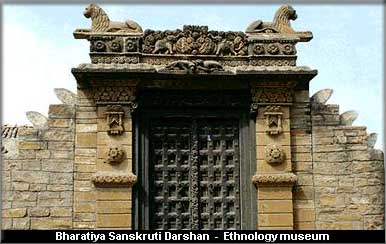|
|
Aina
Mahal
The heritage of Kutch art and culture is displayed in the
Madansihji museum (Aina mahal) Bhuj. The last ruler of Kutch
Maharao Madansinhji established the "Maharao of Kutch
Aina Mahal Trust on 1st January, 1977. Aina Mahal means
a mirror palace. It was created by the artists Ramsinh &
Gaidhar Devshi in the period of Maharao Lakhpatji (1752-61).
In
1757, Rao Lakhpatji visited the emperor Alamgir in Delhi.
He was graced with the title of Mahi Maratib. He welcomed
foreigners in his court. Fortune brought him a man named
Ramsingh malam who specialized in Kutchi architecture, enamel
work, jewellery, tile work and interior decoration. |
| The
great master piece of Ramsingh is the Hall of Mirrors in
the Aina Mahal. The walls are white marble covered with
mirror which are separated by gilded ornaments. The hall
is lit by elaborate pendant candelabra with shades of Venetian
glass. The hall of mirrors is on the second floor of the
Aina Mahal but Ramsingh devised ingenious pumps and siphons
to raise up water to fill the pleasure pool and to operate
fountains which cast spray in an intricate variety of patterns
charming the eye and cooling the air. |
|
The
small state apartment, carpeted with exquisite Kutchi
silk embroidery, its walls paneled high with the same
priceless fabrics still contains Maharao Lakhpatji’s
bed. The hall is filled with a miscellaneous collection
of objects; a Dutch Clock, English and French celestial
globes, some antique pictures, mechanical toys, glass
and china. On the walls of the corridor are a variety
of pictures, some European and many Indian. The Aina Mahal
alone cost eight million kories and was only one of the
many enterprises which the Maharao and Ramsingh undertook
together.
|
The
Kutch Museum
The
Kutch Museum at Bhuj initially formed part of the School
of Art established by Maharao Khengarji on 1st July, 1877.
It is the oldest museum of Gujrat. At the time of Maharao
Khengarji’s marriage, an exhibition of 5897 items
were exhibited and items worth Rs. 3300 were given to the
Museum which necessitated the construction of a new building.
Accordingly,
on 14th November, 1884, the foundation stone for the present
museum building was laid. The building consisting of 2 floors
cost Rs. 32000. The museum is situated almost on the banks
of the beautiful Hamirsar lake and just opposite the Nazar
Baugh garden.
|
On
the ground floor in the central room is displayed Airavat,
an Indian elephant. In 1978 the Govt. of India issued a
postal stamp showing Airavat. The museum has the largest
collections of Kshatrap inscriptions. It also has a fine
collection of Kutch silver, golden and enamelling work,
textiles, wood work, coins, old utensils, arms and other
archeological objects and a section on the communications
of the district. |
|
Bharatiya
Sanskruti Darshan
Mr Ramsinhji K Rathod a scholar of the folk art of Kutch
and winner of many state Government awards has created an
excellent museum in Bhuj which is called Bharatiya Sanskruti
Darshan.
|
The
museum epitomizes the rustic life styles of the Kutchi villager
containing around 4500 exhibits. Also, there are more than
1500 rare books on art and culture. This museum has five
major sections. In the Ethnological section, Sahitya Chitra,
in the central hall can be found rare works of literature.
In other sections are interesting artifacts such as leather
embroidery, wood work, wood carvings, terra cotta, wall
paintings, bead work, stone carvings, musical instruments,
knives and swords and silver work. |
 |
| Inside
one of the huts is the intricately designed "Kothala"
(the treasury). In olden times, ornaments money, and other
valuables of the royalty were kept in the "Kothala". |
|
|














